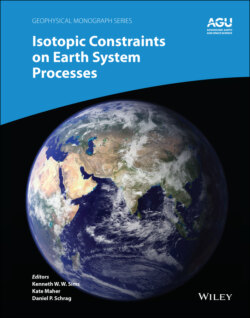Читать книгу Isotopic Constraints on Earth System Processes - Группа авторов - Страница 38
1.6.1. The Hertz‐Knudsen Evaporation Equation
ОглавлениеThe standard formulation for the net flux Ji of an element i between a condensed phase and a surrounding gas is the Hertz‐Knudsen equation:
(1.9)
Ji is the flux of i in moles per unit area per unit time (positive indicating net evaporation), n is the number of atoms of i in the gas molecule containing i, γiv is the evaporation coefficient, γ ic is the condensation coefficient, Pi,sat is the saturation vapor pressure of the gas molecule containing i if equilibrium with the condensed phase were realized, Pi is the pressure of the gas molecule containing i at the surface of the condensed phase, Mi is the molar mass of the gas molecule containing i, R is the gas constant, and T is the absolute temperature. This version of the Hertz‐Knudsen equation applies when there is only one gas molecule containing the element i. In the case of a CAI‐like liquid the dominant gas species of the most volatile elements magnesium and silicon are Mg and SiO (not Si). Since these gas species contain only one atom of the element of interest, n is equal to one in equation 1.9. The total pressure in that part of the solar nebula where the CAIs formed was about 10–3 bars or less (mostly hydrogen with negligible amounts of Mg and SiO) and therefore Pi<<Pi,sat. Equation 1.9 when n=1 and Pi<<Pi,sat becomes
(1.10)
The isotopic composition of the evaporation flux is given by the ratio of the flux of isotopes i and j calculated using equation 1.10 with the further simplification that because of the thermodynamically ideal behavior of isotopes Pi,sat/Pj,sat = Ni/ Nj where Ni/ Nj is the atom ratio of the isotopes in the evaporating material. The equation for the isotopic composition of the evaporation flux is then
(1.11)
The quantity , which we will call α ij, is the kinetic isotope fractionation of the evaporation flux relative to the isotopic ratio of the evaporating material. Prior to having results from vacuum evaporation experiments it was often assumed that , (i.e., the inverse square root of the mass “law”) but as we will see, this is not correct.
